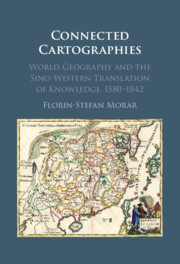Refine search
Actions for selected content:
175 results

Connected Cartographies
- World Geography and the Sino-Western Translation of Knowledge, 1580-1842
-
- Published online:
- 11 December 2025
- Print publication:
- 22 January 2026
Introduction: Human Rights and Distributive Justice
-
- Book:
- In Defense of Economic and Social Human Rights
- Published online:
- 06 November 2025
- Print publication:
- 20 November 2025, pp 1-30
-
- Chapter
- Export citation
Chapter 2 - The Expanding World of Warring States
-
- Book:
- The Roman Empire and World History
- Published online:
- 31 October 2025
- Print publication:
- 30 October 2025, pp 28-55
-
- Chapter
- Export citation
Conclusion - Beyond Globalization – The World Histories for Rome
-
- Book:
- The Roman Empire and World History
- Published online:
- 31 October 2025
- Print publication:
- 30 October 2025, pp 177-186
-
- Chapter
- Export citation
Chapter 1 - Rome and Pre-colonial World History
-
- Book:
- The Roman Empire and World History
- Published online:
- 31 October 2025
- Print publication:
- 30 October 2025, pp 1-27
-
- Chapter
- Export citation

Things of the Past
- A Modern Yearning
-
- Published online:
- 27 October 2025
- Print publication:
- 27 November 2025
-
- Element
- Export citation
Introduction
-
- Book:
- Latin America and Human Rights Politics in West Germany, 1973–1990
- Published online:
- 18 October 2025
- Print publication:
- 18 September 2025, pp 1-23
-
- Chapter
- Export citation
Austrian World Practices: The Vienna Philharmonic and the Global History of Austrian Culture in the Twentieth Century
-
- Journal:
- Central European History / Volume 58 / Issue 3 / September 2025
- Published online by Cambridge University Press:
- 15 July 2025, pp. 332-354
- Print publication:
- September 2025
-
- Article
-
- You have access
- Open access
- HTML
- Export citation
Chapter 1 - Sons of Sunny Italy
-
- Book:
- Emigrant Soldiers
- Published online:
- 05 June 2025
- Print publication:
- 26 June 2025, pp 1-29
-
- Chapter
- Export citation
Law, peace, and world order: Hans Kelsen’s global thought in the 1940s
-
- Journal:
- Journal of Global History / Volume 20 / Issue 3 / November 2025
- Published online by Cambridge University Press:
- 26 May 2025, pp. 334-348
-
- Article
-
- You have access
- Open access
- HTML
- Export citation
The circle of the world: the global diplomacy of Caliph al-Manṣūr
-
- Journal:
- Bulletin of the School of Oriental and African Studies / Volume 88 / Issue 3 / October 2025
- Published online by Cambridge University Press:
- 11 April 2025, pp. 523-538
- Print publication:
- October 2025
-
- Article
-
- You have access
- Open access
- HTML
- Export citation
What is Digital Global History Now?
- Part of
-
- Journal:
- Transactions of the Royal Historical Society / Volume 3 / December 2025
- Published online by Cambridge University Press:
- 24 March 2025, pp. 449-467
- Print publication:
- December 2025
-
- Article
-
- You have access
- Open access
- HTML
- Export citation
US-Japan Conflict and the Rise of the Synthetic in Global Capitalism
-
- Journal:
- Asia-Pacific Journal / Volume 19 / Issue 18 / September 2021
- Published online by Cambridge University Press:
- 14 March 2025, e1
-
- Article
-
- You have access
- Open access
- Export citation
16 - Deglobalizing the Global History of Europe
-
-
- Book:
- Globalizing Europe
- Published online:
- 06 March 2025
- Print publication:
- 13 March 2025, pp 260-270
-
- Chapter
- Export citation
6 - European Social History and the Global Turn
-
-
- Book:
- Globalizing Europe
- Published online:
- 06 March 2025
- Print publication:
- 13 March 2025, pp 76-85
-
- Chapter
- Export citation
5 - Religion and the Global History of Europe
-
-
- Book:
- Globalizing Europe
- Published online:
- 06 March 2025
- Print publication:
- 13 March 2025, pp 66-75
-
- Chapter
- Export citation
10 - Migration and European History’s Global Turn
-
-
- Book:
- Globalizing Europe
- Published online:
- 06 March 2025
- Print publication:
- 13 March 2025, pp 138-158
-
- Chapter
- Export citation
13 - Globalizing Europe’s Musical Past
-
-
- Book:
- Globalizing Europe
- Published online:
- 06 March 2025
- Print publication:
- 13 March 2025, pp 200-219
-
- Chapter
- Export citation
3 - Making Europe’s Economy
-
-
- Book:
- Globalizing Europe
- Published online:
- 06 March 2025
- Print publication:
- 13 March 2025, pp 42-55
-
- Chapter
- Export citation
1 - Global Europe
-
-
- Book:
- Globalizing Europe
- Published online:
- 06 March 2025
- Print publication:
- 13 March 2025, pp 1-26
-
- Chapter
- Export citation
